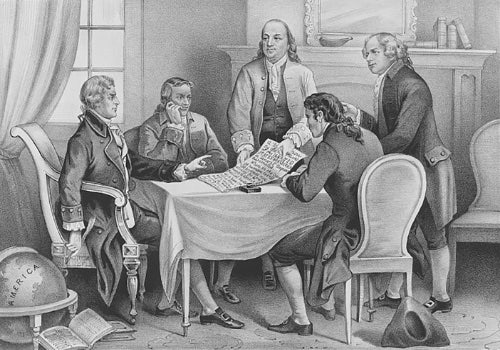


# Celebrating the Digital Potential of the Declaration of Independence

Each year on the Fourth of July, the United States marks Independence Day, celebrating the adoption of the Declaration of Independence by the Second Continental Congress on July 4, 1776. This monumental document signaled a crucial step toward the creation of the United States of America and remains one of the most notable and significant pieces of American history.
While many Americans are familiar with the Declaration of Independence’s role in the Revolutionary War, the establishment of the American government, and the broader ideology of a free democracy, few ponder the actual document or the meticulous process of its creation. Thomas Jefferson’s effort over two weeks to draft the political foundations of a new nation, the multiple revisions by Ben Franklin and John Adams, and the signatures of 56 delegates are often overlooked.
In his autobiography, Ben Franklin provides insight into the collaborative and painstaking process of developing the Declaration of Independence. He describes the numerous drafts, careful edits, and essential changes that shaped one of America’s most influential documents. But what if this crucial text had been crafted in the digital age, using tools like PDFs and electronic signatures?
## Imagining a Digital Declaration of Independence
In 1776, Thomas Jefferson spent 17 days in a rented boarding house in Philadelphia, writing the Declaration of Independence. Without much thought for preserving the drafts, he poured his thoughts onto paper. But imagine if Jefferson could have saved his drafts as PDFs. He could have kept track of previous versions, exported and saved them in different formats, and possibly made life easier for future archivists.
According to the Library of Congress, a rare “original Rough draught” of the Declaration shows the many corrections, additions, and deletions made at each stage. Franklin and Adams reviewed Jefferson’s initial manuscript, making 47 revisions before it was presented to the full Congress for further refinement. By the time the Declaration was ratified, about 100 manual alterations had been made.

Rather than working alone by candlelight, crumpling drafts, and striving for perfection, Jefferson could have benefited significantly from real-time digital document collaboration. With modern tools like Adobe Acrobat, he could have created a link to share the PDF file with delegates, using @ mentions to pinpoint areas needing feedback. This would streamline the review process, allowing multiple reviewers to leave comments and annotations from any location, on any device, in real time.
## Simplifying Edits and Signatures
Ben Franklin, known for his decisiveness, would likely have appreciated the ability to edit the text directly rather than waiting for Jefferson to complete a draft. Modern editing tools integrated with applications like Microsoft 365 within Adobe Acrobat would have simplified the process.
Thomas Jefferson’s frustration with the numerous edits made to his work is evident in his quote, “I wish sincerely, as well for the honor of Congress, as for that of the States, that the Manuscript had not been mangled as it is.” Today’s digital tools could have allowed Jefferson to lock the PDF and disable further edits, preserving the integrity of his original work.
When it came to signing the Declaration, the process was lengthy. Within a month of its ratification, 56 delegates from the 13 colonies signed the document in person, using pen and paper. Travel issues, diseases, and other factors delayed the signing for many delegates. If electronic signatures had been available, the delegates could have used Adobe Acrobat Sign’s Fill and Sign tool to sign the document quickly and easily from anywhere in the country using a web browser or smartphone.

Not only could the Founding Fathers have signed electronically, but they could also have sent reminders to delegates who needed to add their signatures. This efficiency would have been particularly beneficial given the political risk involved in declaring independence from Britain. Document security was paramount, and modern tools like Adobe Acrobat and Acrobat Sign provide encrypted password protection for PDFs, legally compliant e-signatures, and the trusted security of a global brand.
## Digital Advantages for All Documents
Documents are fundamental to business and government operations. They underpin sales deals, employee contracts, procurement orders, and legal agreements. Historically, documents have been central to significant political changes, social movements, and key decisions.
As digital transformation continues, documents will remain critical to recording and endorsing pivotal moments. The Founding Fathers didn’t have access to modern technology, digital tools, or seamless workflows, yet they produced a transformative text that laid the foundation for American democracy. Today, we have the advantage of creating digital documents faster and more efficiently. We can collaborate remotely, work across different devices, and use powerful integrations with flexible e-signature capabilities and top-notch security features.
With Adobe Acrobat, businesses can keep moving forward and stay connected with teams, no matter where they are working. The platform offers a comprehensive set of tools to create, convert, edit, export, sign, and share PDFs. For those moments when a signature is required quickly and securely, Acrobat Sign is the go-to solution.
In conclusion, while the Declaration of Independence was a monumental task achieved without the aid of modern technology, today’s digital tools can vastly improve document creation, collaboration, and security. As we celebrate Independence Day, we can appreciate the historical significance of the Declaration while also recognizing the benefits of digital advancements in document management.
— For more Information, Refer to this article.


































